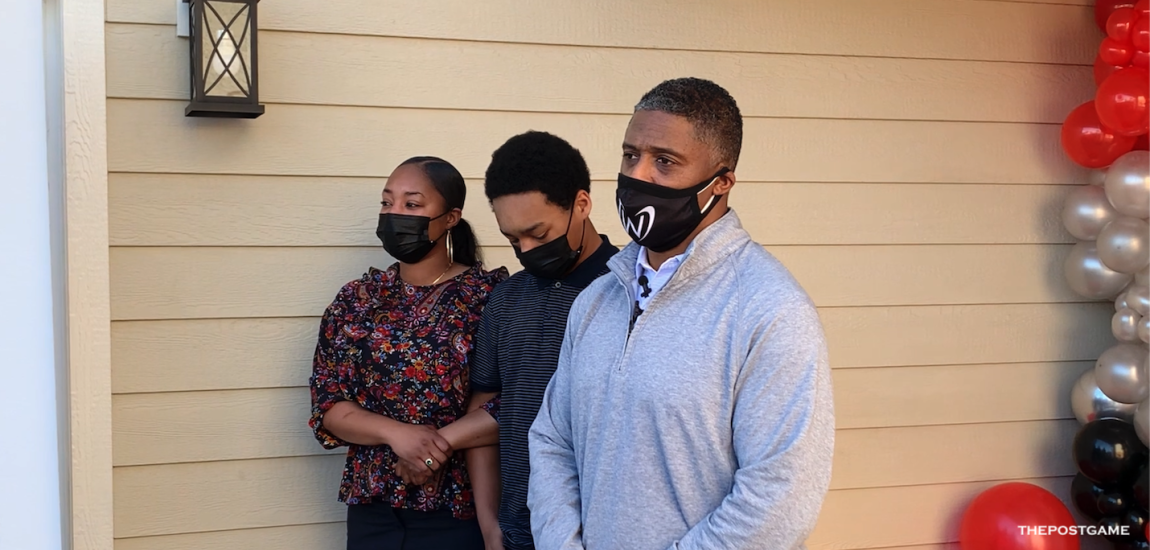After days of dancing back and forth, with everyone from Penn State's fans to the trustees wondering if head football coach Bill O’Brien was going to stay or go, he finally ended the suspense: O'Brien announced he would be leaving State College after two seasons to coach the NFL's Houston Texans.
At first glance, it's an old story: An NFL offensive coordinator gets a chance to lead a legendary college program, then jumps back to the NFL when he's offered the opportunity to become a head coach. But after conducting hundreds of interviews inside Penn State's program to write my latest book Fourth and Long, and several articles, I can tell you it’s not that simple. Or, rather, it's almost that simple -- but it's not what you think.
Dig a little deeper, and you'll see O'Brien's decision -- made at the eleventh hour, after much hand-wringing -- was based as much on the appeal of the Texans' offer as it was the lack of leadership presented by Penn State.
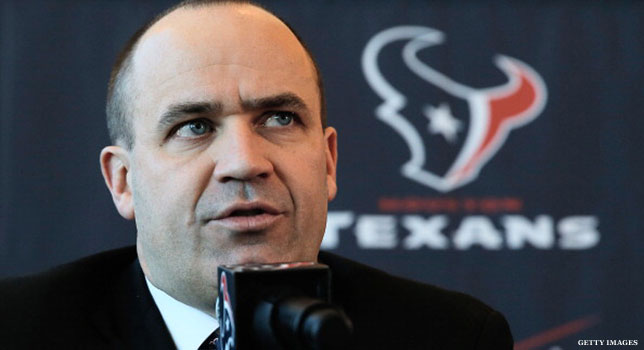
Probably no one felt this more acutely than the players on the 2012 team, Penn State's first after the dismissal and death of Joe Paterno.
"Who was stepping up and taking it?" 2012 senior Michael Zordich asked me. "We were. They never stood up for us. Not the president, not the AD. They were silent. Silent. Thanks. Who was standing up for us? O'Brien -- and that's it."
Trustee Anthony Lubrano, who was elected to the board as an alumnus in the summer of 2012, understands Zordich's frustration. "From 1995 to 2011, until they accepted Graham Spanier’s resignation and fired Joe Paterno, those two were clearly the face of Penn State," he told me. "Since their respective departures, no one has replaced them, and we've struggled to overcome that. New logos and slogans haven't helped, either."
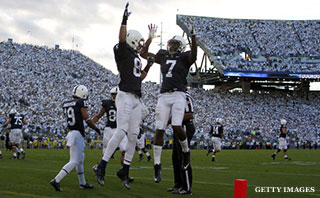
Penn State's problems start with its outdated 30-member Board of Trustees. While other universities elect or appoint their trustees, Penn State uses a bizarre hybrid to fill its Board. This includes the state secretaries of education, agriculture, conservation and natural resources; six appointees by the governor, nine elected by alumni, and six elected by Pennsylvania agricultural societies. It harkens back to the school's founding as a land-grant college. Six additional trustees are selected by a committee representing business and industry.
Although the six business appointees, led by BNY Mellon president Karen Peetz, comprise only one-fifth of the board, they tend to have the most influence, and the nine elected alumni much less.
Consider three key decisions that were driven by just a handful of business appointees:
-- On July 12, 2012, within hours of receiving the damning Freeh Report -- which accused Penn State’s leaders of a "total disregard for the safety and welfare of Sandusky's child victims” - a few business appointees officially accepted the report on behalf of Penn State. That decision, in turn, prompted the NCAA to accept the report in lieu of its own investigation, resulting in severe sanctions.
-- Failing badly to select a permanent president in November 2013 (more on that later).
-- Creating the $4.25 million per year salary for new football coach James Franklin, in early 2014.
The nine elected alumni trustees, in contrast, could count only one representative on one of those committees.
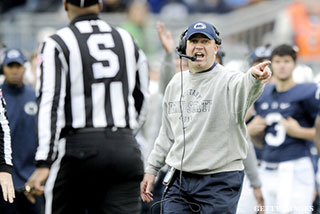
After NCAA President Mark Emmert delivered his famous quote about the "culture problem" with Penn State's football program, in July of 2012, Lubrano, who had just been elected to the board as an alumnus, responded, "We do have a 'culture' problem. But it lies in the board of trustees."
The Sandusky scandal has taken its toll on Penn State, as you'd expect. But right when the football team, at least, seemed poised to emerge from the crisis, the issues with Penn State's leadership have persisted, manifest in their struggles to select a permanent president and to provide crucial support for a football program still in flux.
This brings us to the position of Athletic Director. After longtime AD Tim Curley stepped down in 2011, the process of replacing him has been similarly bumpy and unorthodox. The board quickly named one of its own, David Joyner, as the "Acting Director of Athletics."
Joyner had been an all-American offensive lineman at Penn State in 1971, and went on to become an orthopedic surgeon. He was elected to PennState's Board of Trustees in 2003, 2006, and 2009, taking one of the nine seats reserved for alums, voted on by alums.
Nonetheless, Joyner was an odd choice for athletic director. That Joyner had no experience working in an athletic department was a weakness Michigan, Notre Dame and Oregon had also overlooked in their searches, in favor of business experience. But what business experience Joyner had was not a ringing endorsement for his candidacy. In 2002, he founded a company which operated a chain of gyms called C-5 Fitness. In 2006, the company filed for bankruptcy.
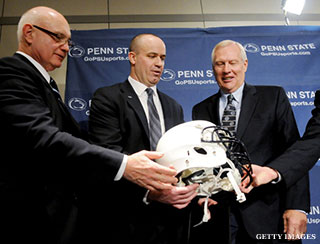
“Some companies do go bankrupt, no matter what you do,” Joyner said to PennLive.com. "I'm certainly not a venture capitalist, but I’m told that successful venture capitalists fail 85 percent of the time."
Messages to the Penn State Athletic Communications office to speak with Dr. Joyner (left in picture, with O'Brien and interim president Rod Erickson) for this story were not returned.
After Joyner took the job, trustee Ira Lubert, a real estate millionaire, arranged for the Joyners to stay in one of his homes in State College, and another in Hershey. Two months later, Penn State named Joyner the permanent athletic director.
The board's decision to hire a fellow trustee attracted the attention of the Pennsylvania auditor general, who released a report in November 2012, stating it created "reasonable public perceptions of insider influence and conflicting interests.”
Penn State dismissed the AG’s concerns, but the players did not. After the 2011 team finished 9-3, without a permanent president, athletic director or head coach, the team captains called a players-only meeting to decide whether to accept the bid to the lowly TicketCity Bowl in Dallas. After a civil discussion, they decided if they represented Penn State's values, they had to go.
All seemed settled -- until Dr. Joyner addressed the team after their vote. According to over a dozen players present, he accused them of being "a bunch of children” for declining the bowl invitation, which prompted Gerald Hodges to stand up and demand Dr. Joyner show more respect. The two started walking toward each other, creating a commotion loud enough for assistant coach Larry Johnson Sr., waiting outside, to come into the room, hold Hodges, and literally escort him out.
Finally, when captain Devon Still told Joyner, "We already decided. We’re gonna go,” Joyner calmed down, and told the team they had their full support, but the players never bought it. After Joyner hired O'Brien, the players asked O'Brien to keep Joyner away from the team -- essentially banning him from their sideline, their locker room and their team meetings -- and Joyner obliged, not appearing before the team again until the 2012 senior banquet.
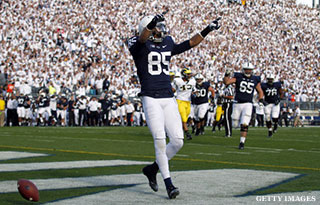
When Dr. Joyner courted Bill O'Brien after the 2011 season, he asked him to FedEx his resume and cover letter, then lost the envelope in the department mailroom for eight days until O'Brien called to make sure they'd received it. O’Brien was smart enough to ask about the possibility of the NCAA punishing the football program, but naïve enough to believe Joyner when he assured O’Brien the NCAA would steer clear.
On July 23, 2012, the NCAA leveled historically severe sanctions against the school for the Jerry Sandusky scandal, leaving Penn State’s football program to face a slow version of the death penalty. But O'Brien and a special class of seniors not only kept the team alive, they thrived, knocking off ranked teams en route to an 8-4 record.
Two days after Penn State finished the triumphant 2012 season by beating eventual Big Ten champion Wisconsin, I sat with Bill and Colleen O'Brien at their breakfast table. "We like it here,” Bill said. "She likes it here, and the kids do, too. We love this team, the families. I love the values here, and I believe in them."
But as he was talking, his cell phone buzzed so often it almost fell off the edge of the table.
It wasn't friends or well-wishers calling, but athletic directors from Boston College, Tennessee, and Arkansas, and the NFL's Philadelphia Eagles, Cleveland Browns and San Diego Chargers. They all wanted to know one thing: What would it take to get O'Brien to jump?
The Monday after the football season ends, college and pro alike, is traditionally the day when the athletic director, the general manager, or the owner calls in the head coach to assess the season just past and to plan for the seasons ahead. But not at Penn State. At least, not in 2012.
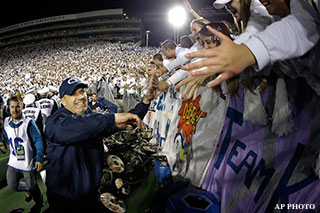
While O’Brien's phone was blowing up, Dave Joyner was on a hunting trip. It was the opening day of Pennsylvania's deer season. When I asked O'Brien about this, he shrugged it off, but then-senior linebacker Mike Mauti did not.
"That enrages me," Mauti told me, in December 2012. "Let's lay it out there: He's the reason we did all this. They hire anyone else, this doesn't happen -- and who knows where the program is? He's it. If O-B leaves ... it's because they didn't do their jobs and do what's right."
Nonetheless, O’Brien declined the overtures from other athletic directors and the NFL, and stayed put in State College. In the spring of 2013, Penn State bumped O’Brien's pay to $3.2 million. To keep up with the never-ending arms race that is modern college football, O’Brien also received assurances from Joyner that he would increase the budget for assistant coaches' salaries, recruiting and facilities face-lifts -- the very things rivals Michigan and Ohio State already have.
O'Brien's players followed up their inspirational 2012 season with an equally surprising 7-5 record this year. After the NCAA greatly reduced Penn State's sanctions, and recruiting picked up accordingly, the program's future suddenly looked much brighter.
But the school’s leadership, from the Board of Trustees to the athletic director, continued to stumble. After the Board set a meeting for November 1, 2013, to name SUNY Upstate Medical University president David Smith to replace interim president Rod Erickson, it canceled the meeting when Smith told one of the committee members he had received roughly $35,000 of unapproved income from a company that did business with the SUNY system. However, in a November 1 letter, SUNY Chancellor Nancy Zimpher informed Smith they had discovered the total was actually $349,295. Smith resigned, but there is a flap about his continuing to draw a paycheck from New York state.
After Penn State's 2013 season, according to insiders familiar with the situation, Joyner failed to follow through on his promises to boost O'Brien's budget for assistant coaches' salaries, recruiting and facilities. At the 2013 senior banquet, one witness said, the tension between the two men was "palpable. You couldn't ignore it." After the event, Dr. Joyner waited more than a week to respond to O'Brien's requests to follow up on his promises. (When I asked O’Brien about these accounts, he did not deny their accuracy.)

Given this, when the NFL's siren song resumed, O’Brien was ready to listen. The Houston Texans offered him the most appealing package: A great contract, a loaded roster, and strong, supportive leadership.
O'Brien based his decision partly on his long-held desire to become a head coach in the NFL, and the Texans' attractive offer. But it wasn't simply about money. It wasn't State College, the Penn State fans or the players, either.
When I reached him last week, he said, "I want to be clear: I love the Penn State fans and always will. They were incredibly supportive, and the players were great. I love those guys. I just felt that this was the best move for me and my family."
Joyner responded to O'Brien's departure faster than he'd responded to O’Brien's phone calls. He lured former Vanderbilt head coach James Franklin to State College for $4.25 million a year -- a third more than O'Brien received his second season. Joyner was also willing to overlook the fact that four of Franklin's players were charged in June for raping an unconscious 21-year old woman in a dormitory, and a fifth player who pled guilty to covering it up.
It is hard not to conclude the Texans wanted O'Brien more than Joyner did, and that Joyner was more eager to hire Franklin than keep O'Brien.
Reached this week, Mauti said of O’Brien's departure, "It doesn't shock me one bit, unfortunately. It didn't take a genius to see it coming. You always try to leave your program better than you found it. That’s what O-B did. He gave us all he had, and that's why I’ll always respect him. I wish him nothing but the best."
O’Brien's career as an NFL head coach has just started. At Penn State, however, instead of basking in the incredible good fortune of finding the right guy during a desperate time, the same school that needed only two head coaches for 62 seasons is now welcoming its second coach in two years.
The years ahead will tell us who made the best decisions. But it’s a safe bet that Penn State University will not return to its former heights until it finally addresses its fundamental problem: the lack of strong leadership.
-- John U. Bacon is the author, most recently, of Fourth and Long: The Fight for the Soul of College Football, a New York Times bestseller. He gives weekly commentary on Michigan Radio, teaches at the University of Michigan and Northwestern's Medill School of Journalism, and speaks nationwide on leadership and diversity. Learn more at JohnUBacon.com.

